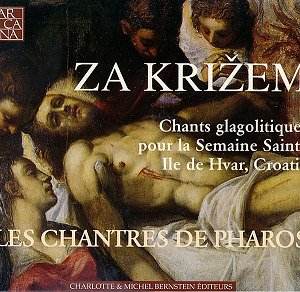|
|
Search MusicWeb Here |
|
 |
||
|
Founder:
Len Mullenger (1942-2025) Editor
in Chief:John Quinn
|
|
|
Search MusicWeb Here |
|
 |
||
|
Founder:
Len Mullenger (1942-2025) Editor
in Chief:John Quinn
|
 |
ZA KRIZEM: Glagolitic
chant for Holy Week from Hvar, Croatia. Recorded June 1999, Church of St. Peter, Stari Grad, Hvar, Croatia |
| CD available for post-free online mail-order or you may download individual tracks. For some labels you can download the entire CD with a single click and make HUGE savings. The price you see is the price you pay! The full booklet notes are available on-line. | |
|
NOTE • Click on the button and you can buy the disc or read the booklet details • You can also access each track which you may then sample or down load. • Further Information. |
|
|
The title of this disc inevitably brings to mind the music of Janáček, and his celebrated Glagolitic Mass in particular. In the case of that work the text of the Mass is sung not in Latin but in Old Slavonic, and the term Glagolitic relates not to the language itself, still less to any kind of ethnic origin, but to a system devised in the 9th century to represent in written form what had previously only existed orally. As for Glagolitic Chant, well, the reference books in my library were strangely silent on the subject, and you would need more ingenuity and staying power than I possess to find out much about it from the internet. So I was glad of the all too brief notes by Magdalena Lupi which accompany this fascinating disc.
The island of Hvar is in the Adriatic, just off the Croatian coast, and is the scene each Holy Week of a traditional pageant whose origin goes back more than six centuries. The ceremony is called Za Krizem, which means Follow the Cross, and is essentially a procession beginning on Holy Thursday and continuing into Good Friday, accompanied by the singing of sacred texts associated with the Easter story. It is a procession for the local people, and priests do not take part. The music was not recorded during the procession, but under studio conditions in one of the churches on Hvar. The sound is absolutely stunning: rich, reverberant but not distractingly so, quite close but full of atmosphere.
The music is sung unaccompanied by a group of some sixteen singers, all men, and, it would seem, villagers rather than professionals. There is a fair amount of solo and unison singing, but the majority is in three parts, or perhaps even four – it’s difficult to tell without seeing any scores. The singing itself is extremely accomplished, there are individual voices of great beauty, and they blend well with each other. There is the occasional suspicion of tuning problems, but there is a certain consistency about this so it may well be a feature of the musical style: there is scope for lots of research here! For the most part the music seems to inhabit the same kind of sound world as Western classical music, with little or no use of exotic scales, for example. The result is extremely sonorous, fervent and passionate, very little of the austere, and much of the chant itself is extremely beautiful. Searching for some kind of comparison to give an idea of what this music sounds like, I would say that there are great similarities between this and the male-voice passages of Janáček’s Mass, and one is also reminded of other traditional male-voice harmony singing styles such as Orthodox chant, and especially traditional Basque groups.
Discs of this kind frequently score highly on the STPB (Spouse Threatening to Pack Bags) Scale, but I don’t think potential purchasers have much to worry about on that front, except perhaps for one track. Having said that, at 7’20" the Lamentations of the Virgin Mary is one of the longest of the seventeen tracks on the disc, and is a particularly choice example of the genre. It begins with a fearsome rattling noise made by…what? Long, low groans follow, then upward slides punctuated by long silences, and all this blossoming only at the very end (and very briefly) into something more recognisably melodic.
I think many people will be tempted to use this disc as a background to some boring and repetitive task, such as building a self-assembly wardrobe or filling in a tax return. It could work extremely well in such circumstances, but any listener not giving it full attention will also miss out on some extremely beautiful and moving singing, magnificently recorded. Charlotte and Michel Bernstein, directors of the French label Arcana, are frequently at the root of enterprising projects, and they are to be congratulated on this courageous issue which will not appear immediately tempting when we come across is in our local record store. But few readers will already be familiar with this material, and this, combined with the strangely compelling nature of the music and the manner of its presentation lead me to recommend it with enthusiasm. William Hedley Strangely compelling music and extremely beautiful and moving singing lead me to recommend this with enthusiasm. … see Full Review |
| ADDITIONAL INFORMATION •
You can sample only 30 seconds (or 15% if that is longer) of a given track. Select from the View tracks list. Each sample will normally start from the beginning but you can drag the slider to any position before pressing play. • PLEASE NOTE: If you are behind a firewall and the sound is prematurely terminated you may need to register Ludwig as a trusted source with your firewall software.
•You will need Quicktime to hear sound samples. Get a free Quicktime download here • If you cannot see the "Sample All Tracks" button you need to download Flash from here.
|
|
|
Return to Index |